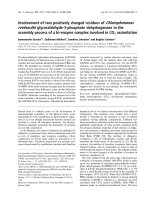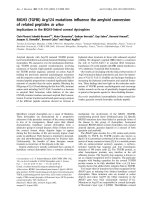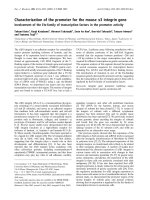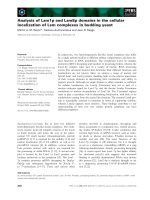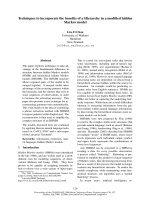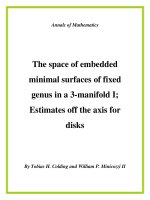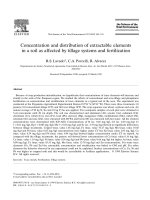Improving the audit process of fixed assets in financial audits conducted by ac auditing and consulting company limited
Bạn đang xem bản rút gọn của tài liệu. Xem và tải ngay bản đầy đủ của tài liệu tại đây (897.58 KB, 86 trang )
NATIONAL ECONOMICS UNIVERSITY
EXCELLENT EDUCATIONAL PROGRAM
BACHELOR THESIS
Major: Auditing
Topic:
Improving the audit process of fixed assets in financial
audits conducted by A&C Auditing and Consulting
Company Limited
Student’s name: Nguyen Manh Cuong
HANOI, 2016
1
NATIONAL ECONOMICS UNIVERSITY
EXCELLENT EDUCATIONAL PROGRAM
BARCHELOR THESIS
Topic:
Improving the audit process of fixed assets in financial
audits conducted by A&C Auditing and Consulting
Company Limited
Student
: Nguyen Manh Cuong
Speciality : Auditing
Class
: Auditing AEP 54
Student’s ID: 11120558
Supervisor : Doan Thanh Nga, PhD
Nguyen Manh Cuong
i
Auditing AEP 54
ACKNOWLEDGEMENTS
This Barchelor thesis contained huge amount of work, research and
dedication. Still, implementation would not have been possible if i did not have a
support of many individuals and organizations. Therefore, i would like to extend
our sincere gratitude to all of them. Foremost, I would like to express my sincere
gratitude to my instructor Doan Thanh Nga, PhD for the continuous support of my
research, for his patience, motivation, enthusiasm, and immense knowledge. Her
guidance has helped me in all the time of research and writing of this thesis.
Without her superior knowledge and experience, the Barchelor thesis would not like
in this quality of outcomes, and thus his support has been essential. My sincere
thanks also goes to my manager – Mr. Khoi, my seniors – Mr. Tuong, Mr. Tuan and
Ms. Tho and staffs working in Financal audited Department of A&C Auditing and
Consulting Company Limited for offering me the summer internship opportunities
in their groups and leading me working on diverse exciting projects. Nevertheless, I
express my gratitude toward our families and friends for their kind co-operation and
encouragement which help me in completion of this Barchelor thesis.
Nguyen Manh Cuong
ii
Auditing AEP 54
TABLE OF CONTENTS
Nguyen Manh Cuong
iii
Auditing AEP 54
STATUTORY DECLARATION
I herewith formally declare that I myself have written the submitted Bachelor
Thesis independently. I did not use any outside support except for the quoted
literature and other sources mentioned at the end of this paper.
I clearly marked and separately listed all the literature and all other sources
which I employed producing this academic work, either literally or in content.
Hanoi, 28/4/ 2016
Signature
ABBREVIATIONS
Nguyen Manh Cuong
iv
Auditing AEP 54
ACCA
CIP
CPA
VAT
VAS
Nguyen Manh Cuong
Association of Chartered Certified Accountants
Construction in process
Certified Public Accountant
Value added tax
Vietnamese Accounting Standard
v
Auditing AEP 54
LIST OF TABLES
Nguyen Manh Cuong
vi
Auditing AEP 54
LIST OF FIGURES
Nguyen Manh Cuong
vii
Auditing AEP 54
PREFACE
In the early 90s of the 20 th century, the trend of international economic
integration of Vietnam has grown significantly. Vietnam's economy has strong
transformation, transition economies from focusing mechanism bureaucracy to
market mechanisms. Open economy poses new requirements. Before the demands
of economy, audit activities have been recognized in Vietnam with the appearance
of the independent organization of accounting and auditing in order to help
individuals and organizations understand the knowledge, enhance understanding
financial literacy and accounting in the new context. The appearance of the
independent audit firm of international and domestic in Vietnam marks an
important milestone in providing audit services and advice for those interested in
the financial figures in Vietnam Male. After more than 20 years of development,
audit has become an intensive operation, a specialized science. The financial
statements reflect the results of operations of the business in general on all aspects
of the business process. A set of information obtained from the processing of the
transaction will eventually be reflected into parts, the items on the financial
statements. Therefore, to achieve the purpose of a comprehensive audit of financial
statements the auditor should consider separate check their parts.
Fixed assets and depreciation plays a very important role in the production
process of a corporate business. So the accounting as well as the setting up of fixed
assets depreciation expense should be recorded properly and accurately calculated.
Moreover, the fixed asset items on the balance sheet accounts for a large proportion
of so errors of this accounting item often cause significant impact to the financial
statements of the enterprise. Therefore, audit of fixed assets and depreciation play a
key role in the audit of financial statements. Aware of this, during practice at A&C
Auditing and Consulting Company Limited - Hanoi Branch, I have chosen the
topic: “Improving the audit process of fixed assets in financial audits conducted
by A&C Auditing and Consulting Company Limited”
Research about auditing fixed assets in the process of auditing financial
statements at the A&C Company, first of all, help me practice theory learned about
the audit fixed assets at the National Economics University, later helped me be
direct observe, learn how to conduct audit of fixed assets by the company A&C
implementation. From that discovery of major irregularities in the audit fixed assets,
learn and draw lessons for themselves about how to consult clients complete fixed
Nguyen Manh Cuong
1
Auditing AEP 54
asset management processes that effectively and accounting fixed assets to match
with the regulations and applicable accounting standards.
In addition to the Introduction and Conclusion, my bachelor thesis includes
three chapters as below:
Chapter 1: Theoretical framework on audit of fixed assets in financial audit
conducted by A&C Auditing and Consulting Company Limited.
Chapter 2: Practice of audit of fixed assets in financial audit conducted by
A&C Auditing and Consulting Company Limited.
Chapter 3: Assessments and recommendation to improve audit of fixed assets
in financial audit conducted by A&C Auditing and Consulting Company Limited.
Due to limited expertise and time to complete, numbers in my thesis have been
extracted from the data collected in the course of auditing fixed assets at A
Company conducted by A&C Auditing and Consulting Company Limited.
And I am very grateful to have teacher Doan Thanh Nga, who helped me a lot
with this thesis, as my supervisor.
Nguyen Manh Cuong
2
Auditing AEP 54
CHAPTER 1: THEORETICAL FRAMEWORK ON
AUDIT OF FIXED ASSETS IN FINANCIAL AUDIT
1.1. Features of fixed assets
1.1.1. Nature and content of fixed assets
Fixed assets are assets that have great value, long duration of use and
involved in many business and production cycles. Fixed assets is a significantly
proportion of accounting items on the balance sheet.
Fixed assets are material and technical of the unit. It reflects the production
capacity and the technical level of the application of the unit operations. Fixed
assets is an important factor in the ability of sustainable growth, labor productivity
growth, thereby the cost of goods and services will reduce.
Fixed assets are assets used for production and business purposes and not
for sale. In the course of use, the fixed assets are consumed. Their value is
converted gradually into operating expenses and will be recovered from the sale of
goods and services for business operations.
• Tangible assets
According to Vietnamese Accounting Standards No. 03, “assets with
physical forms held by enterprises for use in the production and trading in line with
recognized standards of tangible assets”. Tangible assets include: buildings and
structures; machinery and equipment; means of transport, transmission equipment;
equipment, management tools; perennial gardens, working animals; other type of
fixed assets.
These assets are recorded as tangible fixed assets to satisfy simultaneously
all four following criteria:
- Certainly economic benefit in the future from the use of such assets;
- The cost of such assets must be measured reliably;
- Time use estimates over one year;
- Qualified valid under current regulations. According to Circular 45/2013/TTBTC dated 25/04/2013 of the Ministry of Finance shall prescribe the
standards of tangible assets must be valued at 30 million dong or more (start
applying for fiscal year 2014).
• Intangible assets
Intangible fixed assets, according to the Vietnam Accounting Standards No.
04, “the property has no material form, but determining the value and business by
Nguyen Manh Cuong
3
Auditing AEP 54
holding, use in production and business, providing services or other objects for
leasing in line with standards recognized intangible assets”. Intangible assets
include land use rights, distribution rights, patents of invention, trademarks…
An intangible asset is recognized as an intangible asset must satisfy
simultaneously:
- Definition of intangible assets;
- Four recorded following criteria: certainly economic benefit in the future by
bringing such properties; the cost of assets must be measured reliably; time
use estimates over one year; having qualified for the value according to
current regulations.
• Financial lease fixed assets
Financial lease fixed assets, according to Vietnamese Accounting Standards
No. 06, "Leases", promulgated and published by Decision No. 165/2002 dated
31/12/2002 of the Minister of Finance is an agreement between two parties: lessor
and lessee about the lessor transfer use rights of property to the lessee for a certain
period of time to receive money to hire one or more times
Financial lease fixed assets is the leasing of assets which the lessor has
transferred substantially all the risks and rewards associated with ownership of the
leased assets. Property ownership can be transferred at the end of the lease term.
A finance lease agreement must meet 1 of 5 conditions:
- The lessor transfers ownership of the property to the lessee at the end of the
lease term;
- At the inception of the lease, the lessee has the option to purchase the leased
assets at a price lower than the estimated fair value at the end of the lease
term;
- Duration minimum lease assets accounted for most of the time the economic
use of the property even though there is no transfer of ownership;
- At the inception of the lease, the present value of the lease payments
minimum dominate the fair value of the leased asset;
- Leased asset is of specialized kind that only the lessee has the ability to use
no need to change, a major reconstruction.
• Depreciation
Depreciation, according to Circular 200, dated 22/12/2014 of the Minister of
Finance is used to reflect the situation increased, decreased of depreciation and
accumulated depreciation of fixed assets and investment property during use due to
depreciation, and other increase, reduce of fixed assets, investment property.
Nguyen Manh Cuong
4
Auditing AEP 54
In principle, all fixed assets, investment property for lease of the business
related to the production, business (including assets not used, do not need, pending
liquidation) are subject to depreciation in accordance with current regulations.
Depreciation of fixed assets used in production, business are accounted in
production expenses, business expenses in the period; depreciation of assets not
used, do not need, pending liquidation are accounted in other expenses. Special
cases are not depreciated (such as fixed assets of reserves, fixed assets for social
sharing ...), enterprises must comply with the provisions of the current law.
Based on the provisions of law and management requirements of businesses to
choose one of the calculation methods, depreciation according to the law suit for
each fixed assets, investment property. The depreciation method applied to each
fixed asset, investment property must be done consistently and may be changed
when there is a significant change in the way economic interest receivable of fixed
assets and investment property.
Depreciation time and method of depreciation of fixed assets must be
reviewed at least at each financial year end. If the useful life of the asset is
estimated big difference compared to previous estimates, the depreciation period
should be changed accordingly. Fixed asset depreciation methods are changed when
there is significant change estimate how economic recovery of fixed interest. In this
case, must adjust the depreciation expense for the current year and the next year,
and disclosures in the financial statements.
1.1.2. Accounting for fixed assets
1.1.2.1. Accounting items system
Under current accounting system, accounting fixed assets at customers track
on the following accounts:
Table 1.1: Accounting items system of fixed assets
No
211
Concept
Tangible assets
Nguyen Manh Cuong
5
Auditing AEP 54
2111
2112
2113
2114
2115
2118
212
2121
2122
213
2131
2132
2133
2134
2135
2136
2138
214
2141
2142
2143
2147
Buildings and structures perennial gardens
Machinery and equipment
Means of transport, transmission equipment
Equipment, management tools
Working animals
Other type of fixed assets
Financial lease fixed assets
Tangible financial lease fixed assets
Intangible financial lease fixed assets
Intangible assets
Land use rights
Rights issue
Copyright, patents
Trademarks, trade names
Software program
Permit and license
Other intangible assets
Depreciation of fixed assets
Depreciation of tangible assets
Depreciation of financial assets
Depreciation of intangible assets
Depreciation of real estate investment
In addition, in the process of accounting, accountant also uses other related
accounts such as: 217 - Real estate investment; 331 - Payable to sellers; 111 – Cash;
112 - Bank deposits…
1.1.2.2. Bookkeeping and documents system of fixed asset
The books are used for accounting purposes of fixed assets include: book of
fixed assets, registers of fixed assets, book for monitoring fixed assets where used,
the subsidiary ledger, books of general...
The system of accounting documents including: fixed assets increased
accounting documents, fixed assets decreased accounting documents, depreciation
accounting documents of fixed assets.
- Fixed assets increased accounting documents: contracts to buy fixed assets,
bill of sale, delivery records of fixed assets, inventory records of fixed assets,
amortization test records…
- Fixed assets decreased accounting documents: decision disposals of fixed
assets, liquidation records, sale contracts, delivery records and amortization,
revaluation of fixed asset records...
- Depreciation accounting documents of fixed assets: spreadsheets and
allocate depreciation, registration tables depreciation rate...
Nguyen Manh Cuong
6
Auditing AEP 54
1.1.2.3. Organization of accounting for fixed assets
Transactions increased / decreased of fixed assets in company occurs
infrequently but larger scale and related to multiple accounts on the critical nature
of financial reports of a business, such as capital investment, loan ... Can be
summarized accounting process of fixed assets in the company through accounting
figure follows:
Historical cost
Beginning balance
Increase in the
period
Accumulated depreciation
Beginning balance
Liquidation
Liquidation
Ending balance
Depreciation expenses
in the period
Ending balance
Profit / Loss of liquidation
Depreciation costs
Figure 1.1: Generalization of fix assets accounting procedures
1.1.3. Potential errors and frauds
When conducting the audit of fixed assets, the auditor needs to understand the
understanding of audit risk with fraud and errors in the economic transactions
related to fixed assets. Common risks in the audit of its fixed assets including:
1.1.3.1. The errors exist in the transaction of fixed assets
Fixed asset management is not close: incomplete records of fixed assets, fixed
assets not transfer ownership to the unit but was recognized in the balance sheet; no
books and cards detailing each fixed asset.
The accountants forget to record its transactions related to fixed assets that
should have been recorded in the book. For example, accountant only record
Nguyen Manh Cuong
7
Auditing AEP 54
increased fixed asset accounting which are not recording transferred funds.
Wrong determination of accounts in the case should have been Debit or Credit
in this accounting item but the accountant record to another accounting item
inconsistent with transaction such services incurred when businesses conduct minor
repairs of fixed assets, cost of repairs may that must be accounted into business
expenses in the accounting periods, the accountant recorded in the Debit fixed
assets (Acc. 211) to increase the value of its fixed assets on the balance sheet.
Errors in the record accounting process and the transfer of accounting books.
This is a common mistake of fixed assets that auditors have to pay attention. In the
record process, the accountant may inadvertently recorded the amount of bias, the
upside than the amount stated in the documents; accountants can also confuse while
transferring data from the journal to the ledger.
Misclassification: assets are not sufficient indicators recorded fixed assets but
are recognized as fixed assets, accounting confuse between tangible fixed assets and
intangible assets. Incorrect classification of intangible assets: land use rights, the
cost of compensation and site clearance ... Noting increase their costs of intangible
assets that are not strictly defined as the cost of establishing the company, the cost
for the period research…
Duplicate errors: recorded several times a transactions in the different books.
Errors due to poor level of accountant lead to mistake when record transactions
arising in the book or when the new regime issued, accountant don’t know the
content of all transaction or do not fully understand the transaction should lead to
wrong errors in the accounting process.
1.1.3.2. The frauds exist in the transaction of fixed assets
In fact, the cause-related transaction of fixed assets being reflected
discrepancies by the accountant deliberately because many different purposes. In
terms of transactions nature, intentional violations are critical nature, the frauds
often have arrangements so during the audit fixed assets items, the auditor need
special attention reviews. Some fraud generally occurs in practice, such as:
• The frauds to embezzle appropriation difference value between invoices and
actually incurred, such as false invoicing recorded additional cost of fixed
assets by falsifying invoices when shopping or decrease the liquidation value
by collusion with third parties, repair documents, forgery of vouchers
relating to procurement fixed asset’s cost. Accountant records repair costs
Nguyen Manh Cuong
8
Auditing AEP 54
higher than the fact to appropriate the difference as compared with the
reality.
• Records of bogus economic transactions involving fixed assets, such as
record to the cost of fixed assets some incurred bogus cost as interest
expense; cost overhaul fixed assets non-upgrade, do not increase the
capacity or time to use.
• Attempt to conceal documents, omitting the economic transactions in order
to achieve their own interests as deliberately not record the proceeds from
the liquidation fixed assets fully depreciated to usurp part of this money.
• Deliberately misapplied existing accounting regulations and legal documents
related as applicable depreciation rates faster than prescribed, depreciated
against fixed assets fully depreciated to increase spending charges to reduce
corporate income tax
1.1.4. Key internal controls of fixed assets
In fixed asset management, companies track both in artifacts and value of
fixed assets.
In terms of artifacts, manage the quantity and quality of the fixed assets. In
terms of quantity, fixed asset management department to ensure adequate supply
information on the capacity, to meet the requirements of the business. In terms of
quality, ensuring the preservation to avoid damage, loss of detail parts reduces the
value of fixed assets. To do good work, each unit should develop the rules to
preserves and use of fixed assets reasonably, consistent with its operational
characteristics. Also to use effectively fixed assets, the unit should develop
economic and technical norms for each type, each group of fixed assets. On that
basis, the company assigned a reasonable plan, particularly for parts management
and individual employees to fit management requirements and characteristics of the
unit. With large-scale units, can choose the model of centralized management of
fixed assets and when need, be able to mobilize to the department. Small-scale units
are usually applied distributed management model, according to which the assets
are allocated to each department for preservation and use. With medium-sized units,
fixed asset management model combining centralized and distributed generally
more appropriate. In this case, the fixed assets are machinery and equipment of high
value, used in many different parts are managed in general warehouse, fixed assets
has its own characteristics suitable for each department operation are assigned
directly to the part to manage. Organization management of fixed assets in line with
management requirements and operational characteristics will create favorable
Nguyen Manh Cuong
9
Auditing AEP 54
conditions to streamline operations, improve technology, efficiency of fixed assets
in industry.
In terms of value, company determine the historical cost and remaining value
of investment, procurement and transfer fixed assets. Company must calculate the
exact, full depreciation of fixed assets and depreciation expense allocation
appropriate to the product cost. Also, they must closely monitor the situation
increased, reducing the value of fixed assets when conducting repairs, dismantling,
upgrading, improvement and revaluation of fixed assets. Based on the management
of fixed assets in terms of value, the unit will adjust the fixed assets plan (increasing
or decreasing) by types of fixed assets in line with operational requirements of the
unit.
To manage fixed assets, each company are building regulations, guidelines
and procedures for preserving and amortization. All parts in the company must
respect and strictly implement the regulations. Some of the principles and
provisions of units often posed include:
Firstly, the division of responsibility, there should be a separation between the
preservation and recording the transaction. Accordingly, the fixed asset manager
may not simultaneously be the fixed assets accountant. If not separate the two types
of transactions will easily occur irregularities or control capability is limited.
Secondly, need to clearly define the authority of each management level for
the ratification of its transactions relating to purchase transfer, liquidation or sale of
fixed assets. Fixed assets have big value so this rule should be especially respected.
Thirdly, a division of authority approval with the preservation of fixed assets.
Avoid using fixed assets conservator is also the decision on the sale and transfer of
assets, easily lead to loss of property caused by the abuse of power free sale,
transfer or liquidation of fixed assets.
Finally, build storage fixed assets systems such as warehouse, fencing; assign
responsibility to protect, provisions strict procedures for the transportation of fixed
assets from the company.
Due to the great value of fixed assets and long-term use so the management of
fixed assets requires tight right from the procurement, transfer to the liquidation of
fixed assets. In the accounting period, strictly implement the process of transferring
securities from fixed assets will create favorable conditions for management,
inspection and control of fixed assets.
1.2. Audit objectives in auditing fixed assets
Fixed assets are always accounted for a large proportion in the total asset
Nguyen Manh Cuong
10
Auditing AEP 54
value of the units and depending on the business, the business situation of
enterprises. So in any case, fixed assets reflects device status and the technical basis
of the enterprise. This make fixed assets become an important accounting item
when conducting audit financial statements. On the other hand, because the cost of
fixed assets is huge and slow capital turnover ability so conducting audit fixed
assets items will help auditors assess the economics and efficiency of investment in
fixed assets thereby making capital investment orientation and sources used to
invest more efficient.
In every job, there is always need objectives to aspire to, and with operations
audit too. Audit objectives are needed to reach, at the same time is a measure of the
results for each of the audit. Audit procedures for fixed assets towards the following
objectives:
Table 1.2: Audit objectives in auditing fixed assets
General audit
Audit objectives in auditing fixed assets
objectives
Pursuant
- Transactions increased, decreased, depreciation are recorded
reasonable
appropriately.
- The balance is reflected reasonably in the financial statements.
Exists and real - Fixed assets are recorded is real.
- Transactions increased, decreased, depreciation in the year are real.
- All fixed assets are presented in the balance sheet (including
financial lease fixed assets) actually exist in reality at the end of the
fiscal year.
Completeness - The transactions and amounts arising are adequately reflected,
expenses and income from the liquidation or sale are fully accounted.
- All fixed assets owned by units at the end of the fiscal year must be
recorded on the balance sheet.
Ownership
Fixed assets were purchased and fixed assets were recognized in the
balance sheet are owned by enterprise or enterprise has long-term
control.
Assessment
- Historical cost of fixed assets and the remaining value are assessed
and allocation in accordance with accounting principles.
- Depreciation is calculated in accordance with consistent between
periods and reasonable allocation in expenses during the period, and
in accordance with current regulations.
Exactly
- Depreciation is calculated according to the percentage. Purchases in
the current year on the list of buying must uniform with general book;
increase, decrease, depreciation is recorded correctly and cumulative
Nguyen Manh Cuong
11
Auditing AEP 54
Presentation
and
publication
amount in line with aggregate accounts on the books.
-The details of balance on ledger must match the data on the details
book of fixed assets.
- The data transferred between the accounting books and financial
statements must be done correctly and in accordance with accounting
principles.
-The fixed assets categories must be classified correctly in each subaccount in the financial statements.
- Announced the depreciation method.
- Fixed assets are shown in groups of assets with the same
depreciation rate.
1.3. Sequence in auditing fixed assets in financial audits
Process audit is an audit methods system to help the auditors collect sufficient
audit evidence to achieve the audit objectives. Audit fixed assets items also need to
comply with the general audit of the financial statements. All companies are
increasingly in development and improvement the audit fixed assets, in order to
constantly improve the quality of services provided, the search market.
Audit fixed assets also common sequence of the audit financial statements
consists of three phases: audit planning, audit performance and audit complete.
However, depending on the scope of the audit and the specific characteristics of the
customer that the audit procedures have been changed accordingly to ensure that the
audit objectives.
Nguyen Manh Cuong
12
Auditing AEP 54
Figure1.2: Audit progress of fixed assets
1.3.1. Audit planning
Audit planning is the first step in the work to organize the audit, have an
important role to govern the quality and overall effectiveness of the entire audit.
During this period, technicians perform the work necessary to prepare an audit plan
as: assess the acceptability of the audit and determine the scope of the audit
objectives, selecting the audit staff of contracting accountant; gather information,
and most importantly is design a specific audit program to perform the audit.
When planning the audit, the need to understand the following issues:
Nguyen Manh Cuong
13
Auditing AEP 54
1.3.1.1.Innial audit planning
Auditors assess whether to provide audit services for clients or not based on
questionnaires assessed accepted existing customers.
1.3.1.2. Understanding the entity’s business and its environment
Gather information about the legal obligations of the client. For the audit fixed
assets, the need to collect legal documents and records such as minutes of the
capital contribution, handing over funds, the documents relating to the contribution
of capital in fixed assets...
Learn about the business situation of the customer. Its include business
operations and business results of the client, finding out this information will help
auditors determine whether clients have multiple fixed assets or not and fixed assets
have a material effect to the financial statements of the client or not.
Business environment and external factors of production and business have an
impact on client as economic - social, legal...
The client's objectives and strategies that business leaders set out to achieve
this goal. The strategic objectives that will tell in future enterprises have invest,
purchase, liquidation or sale of fixed assets or not.
1.3.1.3. Preliminary analytical procedures
Analytical procedures are applied to all audits and are implemented in all
stages of the audit by the auditors. According to the Vietnam Auditing Standards
No. 520- Process analysis: "Analysis is the analysis of data, information, the
important ratio to find out trends and the relationship or there is a conflict between
relevant information with the expected value”
After collecting preliminary information about customers, auditors start to
perform analytical procedures. In this stage, auditors often adopt two most popular
analytical procedures:
• Horizontal Analysis: For fixed assets item, auditor can compare figures last
year with current year, which saw these fluctuations and to determine the
cause. Also auditor can compare client’s information with data from the
industry.
• Vertical Analysis: the analysis is based on comparison of the proportion of
the targets and items on the financial statements. For fixed assets, auditor
can calculate a margin as the ratio of self-financing, investment yield...
1.3.1.4. Understanding internal control and assess control risk
The research for internal control of client and assess control risk help auditors
Nguyen Manh Cuong
14
Auditing AEP 54
to design audit procedures appropriate for accounting items of fixed assets, assess
the volume and complexity of the audit, from that can estimate the time and
determined the audit focus.
The more effective internal control, the smaller control risk and vice versa, the
higher control risk, the internal control weaknesses.
Auditors conducted survey internal control on the following two main aspects:
- How internal control for fixed asset items are units design?
- How internal control for fixed asset items are units perform?
Auditors conducted surveys internal control on the following forms:
- Interviews with employees of the Company.
- Visiting the fact of fixed assets.
- Check documents related to fixed assets.
- Get confirmation in writing by a third party (if necessary).
- Observe procedures for Internal Control and Risk of fixed assets.
- Reworked control procedures.
After carrying out the above work, the auditor should assess control risk and
design tests of control. This work was carried out as follows:
- Define the type of fraud and errors may occur in fixed asset items.
- Evaluate the existence of internal control in detecting and preventing fraud and
errors.
- If the level of risk control assessment is not as high as the maximum and auditors
deems potentially reduce control risk was assessed down to a lower level, auditor
will define necessary test of control. Conversely, if the control risk assessment
deems high and is unable to reduce in fact, the auditor should not perform test of
control that must be conducted in the substantive test in reasonable level.
For fixed assets items, the auditor need client’s information about internal
control system for this item. The system is considered to be an effective is
expressed through the protection and proper management. When learning system
for internal control of fixed assets, auditor need to consider the following issues:
- Enterprise has planning and budgeting for shopping fixed assets or not?
- Enterprise has regular reconciliation between the subsidiary ledger and general
book or not?
- There are periodic inventory and compare it with the accounting books or not?
- The difference between the estimate and the actual price may be reviewed
regularly and approved or not?
- When selling or liquidating fixed assets, company has established the council of
Nguyen Manh Cuong
15
Auditing AEP 54
liquidation or sale including members as prescribed or not?
- Corporate has applied accounting regime, the method of depreciation and
amortization is appropriate or not?
Besides auditor also consider possible asset management as well as the
development of regulations, guidelines and procedures on asset preservation.
1.3.1.5. Assessment of audit materiality and audit risks
• Assessment of audit materiality
Auditor conduct audit procedures initial estimates for the materiality to the
entire financial statement then allocated to the parts of the financial statements.
Based on the changes, the characteristics of the business activities of enterprises...
auditor allocate initial estimate of materiality for fixed assets. From there, in the
audit implementation stage, auditor determine the difference may be acceptable.
When the difference is larger, depending on the level affect the financial statements,
and require adjustments to be accepted by unit that the auditor express an opinion
about the acceptance or exclusion criteria fixed assets and depreciation.
• Assessment of audit risk
Audit risk - AR is determined:
AR = IR x CR x DR
Inside: IR: Inherent Ricks
CR: Control Ricks
DR: Detection Ricks
Inherent risk: For fixed assets, inherent risks are often judged based on the
characteristics of the customer's business, or the results of previous year's audit, or
policy management and accounting reports of customers for fixed assets. For
example, in buying fixed assets, frequently liquidation may also contain more risks
and mistakes.
Control risk: assessing audit risk is mainly based on information about the
validity, through the research on Internal Control systems which based on
interviewing customer and observing real situation. Weak controlling environment
will make it more difficult to prevent, detect violations, so it leads to high risk and
vice versa.
Detection risk is the chance that an auditor will not find material
misstatements relating to an assertion in an entity's financial statements through
substantive tests and analysis. Detection risk is the risk that the auditor will
conclude that no material errors are present when in fact there are.
Nguyen Manh Cuong
16
Auditing AEP 54
Audit Risk: Auditors should assess the possibility of auditors in case they
cannot detect errors related to fixed asset items. Thus, auditors should be alert to
avoid these situations that may lead to undetected errors, such as detect evidence
but no noticeable flaws; incompletely implement audit procedures that leads to
ignored violations ...
Materiality and risk have close relationships with one another, if the level of
acceptable error (or materiality) are appreciated more, the audit risk will be lowered
and vice versa. In audits, audit risk as small as possible because it ensures the best
audit results.
When evaluating potential risks, auditor based on factors such as:
- The nature of business clients: clients operating in the manufacturing sector
have the largest volume of fixed assets and the potential risks related to the fixed
asset item is higher than clients active in the field of trade or services.
- The results of the previous audit
- Honesty of Directorate
- The accounting estimates
…
When assessing audit risk, auditors mainly enters the detection measures the
potential risk and minimize risks, design and implement the audit methodology
necessary to fully collect audit evidence.
1.3.1.6. Designing audit program
Audit program of fixed assets was designed in three parts: test work, test
analysis and test directly the balance. The content of audit program usually consists:
documents that requires customers to prepare; the specific audit objectives for fixed
asset items; the work that need to be carried out, the specific audit procedures:
analytical balances procedures of fixed assets, detailed audit procedures for increase
or decrease transactions, and procedures to check the balance of fixed assets.
(Appendix No. 1)
1.3.2. Audit implementation
Conducting an audit is the process of using the audit techniques to adapt to
specific audit objectives to gather audit evidence. Perform audits undergone three
sections: performing tests of control, analytical procedures and tests of detail
1.3.2.1. Performing tests of control
The objectives of the test of control: understanding structure of internal
control for fixed assets, assess the level of control risk. Test of control is done only
Nguyen Manh Cuong
17
Auditing AEP 54


